#30 November 1803
Explore tagged Tumblr posts
Text














In New Orleans, Spanish representatives officially transferred the Louisiana Territory to a French representative on November 30, 1803. Just 20 days later, France transferred the same land to the United States as the Louisiana Purchase.
#Palo Duro Canyon State Park#Texas#Gateway Arch#St. Louis#Missouri#New Mexico#Mississippi River#cityscape#landscape#USA#original photography#summer 2014#Louisiana Territory#France#US history#30 November 1803#anniversary#Santa Fe#Cathedral Basilica of Saint Francis of Assisi#Oklahoma City#Oklahoma#Tucumcari#Gallup#tourist attraction#landmark#white colonialism#vacation#travel#architecture
1 note
·
View note
Text
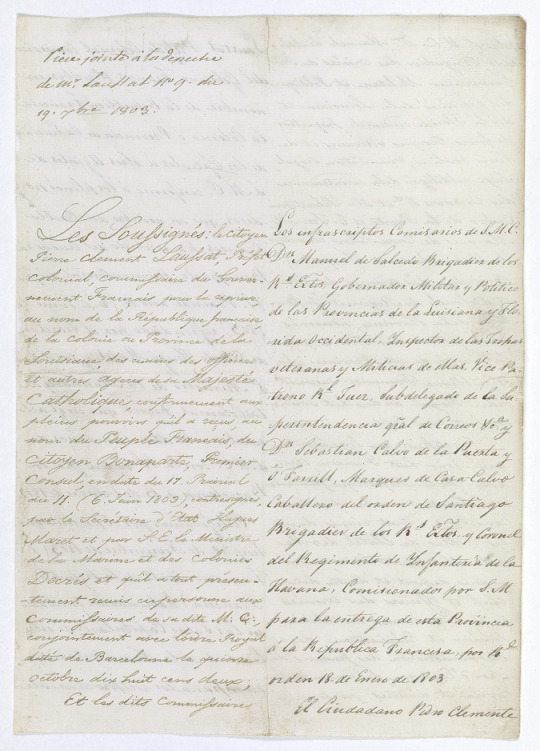
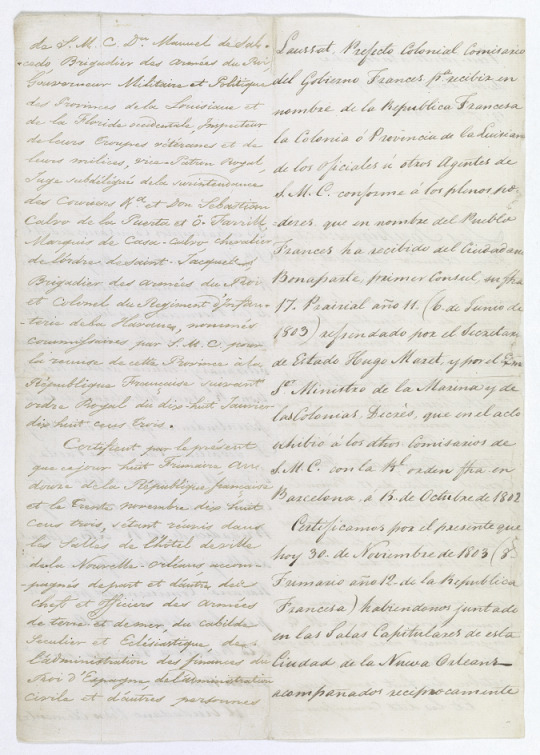
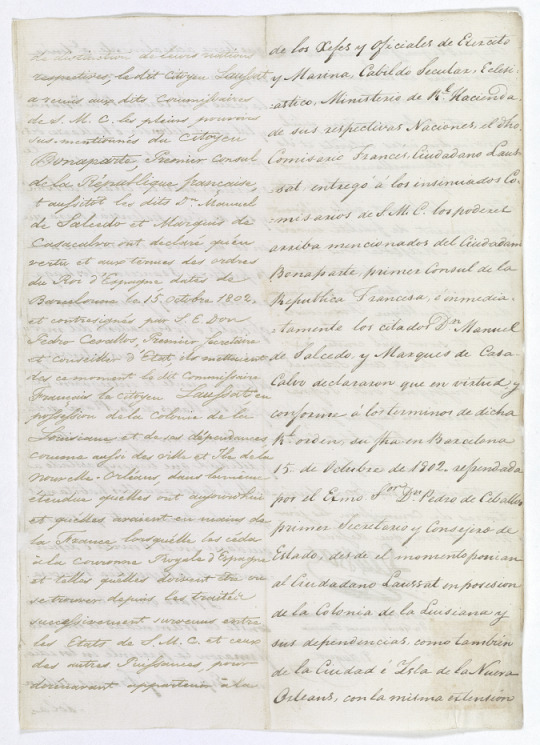
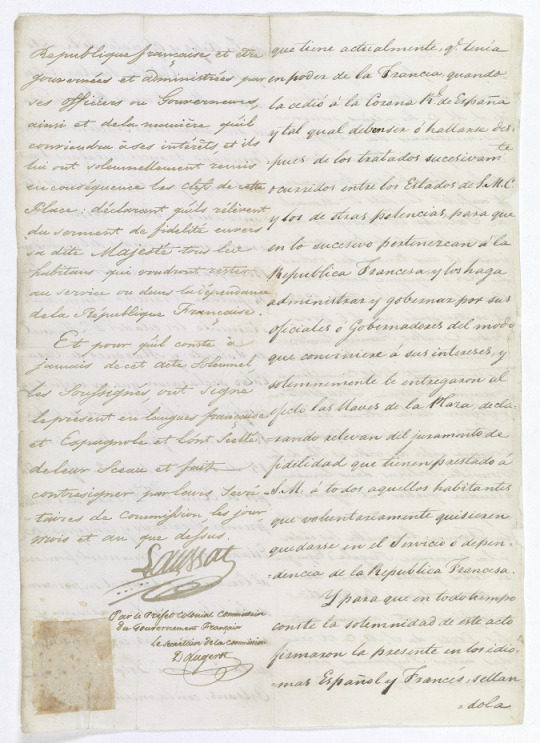
Original Protocol of the Delivery of Louisiana by Spain to France, at New Orleans on November 30, 1803
Record Group 11: General Records of the United States GovernmentSeries: Perfected TreatiesFile Unit: TS 86 AO: Treaty for the cession of Louisiana - English and French texts
[Handwritten] Pièces jointes à la depeche de Mr. Laussat n[']o 9. du 19. 7bre 1803. [Main body of document follows; French-language text on the left; Spanish-language text on the right (this pattern continues throughout the body of the document).] [French text follows -- first:] Les Soussignés : le citoyen Pierre Clement Laussat, Préfet colonial, commissaire du Gouvernement Français pour la reprise, au nom de la République Française, de la colonie ou Province dela Louisiane, des mains des officiers et autres agens desa Majesté Catholique, conformement aux pleins pouvoirs qu'il a reçus, au nom du Peuple Francais, du Citoyen Bonaparte, Premier Consul, en date du 17. Prairial an 11. (6. Juin 1803), contresignés, par le Secrétaire d'Etat Hugues Maret et pour S. E. le Ministre de la Marine et des Colonies Decrés et qu'il a tout présentement remis enpersonne aux Commissaires de sa dite M. C., conjointement avec l'ordre Royal daté de Barcelonne le quinze Octobre dix huit cens deux; Et les dits Commissaires [Spanish-language text follows (on right on original sheet/image):] Los infrascriptos Comisarios de S.M.C. D[']n. Manuel de Salcedo Brigadier de los R[']s Extos,.Gobernador Militar y Politico de las Provincias de la Luisiana y Florida Occidental, Ynspector de la Tropas veteranas y Milicias de ellas, Vice Patrono R[']l Juez, Subdelegado de la Superintendencia g[']ral [with tilde over the "r"] de Correos y c.[']a [?] y D[']n. Sebastian Calvo de la Puerta y O Farrill, Marques de Casa-Calvo Caballero del orden de Santiago Brigadier de los R[']s Ex[']tos, [with tilde over the "t"] y Coronel del Regimento de Ynfantería de la Havana, Comisionados por S.M. para la entrega de esta Provincia á la Republica Francesa, por R[']l. orden 18.. de Enero de 1803. El Ciudadano Pedro Clemente [full transcription at link]
36 notes
·
View notes
Photo

Battle of the Little Bighorn
The Battle of the Little Bighorn (25-26 June 1876) is the most famous engagement of the Great Sioux War (1876-1877). Five divisions of the 7th Cavalry under Lt. Colonel George Armstrong Custer (l. 1839-1876) were wiped out in one day by the combined forces of Sioux, Cheyenne, and Arapaho warriors under the Sioux chief Sitting Bull (l. c. 1837-1890).
Custer located Sitting Bull's camp by the banks of the Little Bighorn River (known to the local Native Americans as the Greasy Grass) in modern-day Montana but had no idea how large it was or how many warriors were present. Having been given a free hand to wage total war against the Plains Indians, Custer divided his command as he had in 1868 at the Washita Massacre. His plan was to attack the camp from opposite sides and close on it in a pincer movement, capturing the women and children as hostages, and forcing whatever warriors had not been killed to surrender. He sent Captain Frederick Benteen (l. 1834-1898) to scout, and Major Marcus Reno (l. 1834-1889) to position himself to strike at the far side.
When Reno launched his attack, however, he was met by a large force of warriors under Sioux war chief Gall (l. c. 1840-1894). Benteen, who had been ordered to bring ammunition to Custer's position, instead tried to support Reno but wound up joining him in retreat. While Gall was driving back Reno and Benteen, Sioux war chief Crazy Horse (l. c. 1840-1877) led a charge against Custer's position.
Custer and all five companies with him were killed in what has come to be known as "Custer's Last Stand." The battle was a decisive Native American victory but could not be capitalized upon because of the public outcry for revenge for the death of Custer, a popular hero of the American Civil War who had also made a name for himself as an Indian Fighter.
After the Battle of the Little Bighorn (also known as the Battle of the Greasy Grass), the Native American leaders went their separate ways to avoid capture and execution. The last major engagements of the Great Sioux War were US victories (or a draw, in the case of the Battle of Wolf Mountain), and, with the Sioux, Cheyenne, Arapaho, and others pushed onto reservations, the Great Plains were open for colonization.
Background
According to the Yanktonai Sioux Chief Lone Dog's Winter Count (a yearly account of events from 1800-1870), "White soldiers made their first appearance in the region" in 1823-1824 (Townsend, 128). The Sioux had little to do with them until 1854 when 2nd Lieutenant John L. Grattan arrived at the camp of Sioux Chief Conquering Bear (l. c. 1800-1854) and demanded the surrender of a man he claimed had stolen a cow from a passing wagon train of Mormons. Conquering Bear refused the demand, Grattan's men opened fire (mortally wounding Conquering Bear), and the Sioux then slaughtered Grattan and the 30 troops under his command in what came to be known as the Grattan Fight or the Grattan Massacre, leading to the First Sioux War of 1854-1856.
Prior to the Grattan Fight, the US government had negotiated land rights and territories with several nations of Plains Indians, including the Sioux and the Cheyenne, through the Fort Laramie Treaty of 1851, which stipulated, among other terms, that the United States had no claim on the lands occupied by those nations. Southern Cheyenne Chief Black Kettle (l. c. 1803-1868) was among those who signed the treaty, which was never honored by the United States and was broken in 1858 when gold was discovered in the region, prompting Pike's Peak Gold Rush and an influx of settlers. Further encroachments led to the Colorado War (1864-1865), during which Black Kettle's peaceful village, flying the American flag and the white flag of truce, was attacked in the Sand Creek Massacre of 29 November 1864.
Black Kettle at Sand Creek
Stone Rabbit (CC BY-SA)
As more settlers claimed Native American lands as their own, Oglala Sioux Chief Red Cloud (l. 1822-1909) launched Red Cloud's War (1866-1868) in defense of his people's land and to force the United States to honor its treaty. The war concluded with the Fort Laramie Treaty of 1868 but, that same year, Black Kettle, his wife, and between 60-150 Cheyenne and Arapaho were slaughtered by troops under Custer's command at the Washita Massacre on 27 November. The treaty of 1868 established the Great Sioux Reservation, but this was broken when, in 1874, Custer discovered gold in the Black Hills, sacred to the Sioux (and other nations) and part of the lands promised them. The Black Hills Gold Rush of 1876 that resulted from Custer's find ignited the Great Sioux War when the US government demanded the Sioux sell the Black Hills and the Sioux refused.
Continue reading...
21 notes
·
View notes
Text
The napoleonic marshal‘s children
After seeing @josefavomjaaga’s and @northernmariette’s marshal calendar, I wanted to do a similar thing for all the marshal’s children! So I did! I hope you like it. c: I listed them in more or less chronological order but categorised them in years (especially because we don‘t know all their birthdays). At the end of this post you are going to find remarks about some of the marshals because not every child is listed! ^^“ To the question about the sources: I mostly googled it and searched their dates in Wikipedia, ahaha. Nevertheless, I also found this website. However, I would be careful with it. We are talking about history and different sources can have different dates. I am always open for corrections. Just correct me in the comments if you find or know a trustful source which would show that one or some of the dates are incorrect. At the end of the day it is harmless fun and research. :) Pre 1790
François Étienne Kellermann (4 August 1770- 2 June 1835)
Marguerite Cécile Kellermann (15 March 1773 - 12 August 1850)
Ernestine Grouchy (1787–1866)
Mélanie Marie Josèphe de Pérignon (1788 - 1858)
Alphonse Grouchy (1789–1864)
Jean-Baptiste Sophie Pierre de Pérignon (1789- 14 January 1807)
Marie Françoise Germaine de Pérignon (1789 - 15 May 1844)
Angélique Catherine Jourdan (1789 or 1791 - 7 March 1879)
1790 - 1791
Marie-Louise Oudinot (1790–1832)
Marie-Anne Masséna (8 July 1790 - 1794)
Charles Oudinot (1791 - 1863)
Aimee-Clementine Grouchy (1791–1826)
Anne-Francoise Moncey (1791–1842)
1792 - 1793
Bon-Louis Moncey (1792–1817)
Victorine Perrin (1792–1822)
Anne-Charlotte Macdonald (1792–1870)
François Henri de Pérignon (23 February 1793 - 19 October 1841)
Jacques Prosper Masséna (25 June 1793 - 13 May 1821)
1794 - 1795
Victoire Thècle Masséna (28 September 1794 - 18 March 1857)
Adele-Elisabeth Macdonald (1794–1822)
Marguerite-Félécité Desprez (1795-1854); adopted by Sérurier
Nicolette Oudinot (1795–1865)
Charles Perrin (1795–15 March 1827)
1796 - 1997
Emilie Oudinot (1796–1805)
Victor Grouchy (1796–1864)
Napoleon-Victor Perrin (24 October 1796 - 2 December 1853)
Jeanne Madeleine Delphine Jourdan (1797-1839)
1799
François Victor Masséna (2 April 1799 - 16 April 1863)
Joseph François Oscar Bernadotte (4 July 1799 – 8 July 1859)
Auguste Oudinot (1799–1835)
Caroline de Pérignon (1799-1819)
Eugene Perrin (1799–1852)
1800
Nina Jourdan (1800-1833)
Caroline Mortier de Trevise (1800–1842)
1801
Achille Charles Louis Napoléon Murat (21 January 1801 - 15 April 1847)
Louis Napoléon Lannes (30 July 1801 – 19 July 1874)
Elise Oudinot (1801–1882)
1802
Marie Letizia Joséphine Annonciade Murat (26 April 1802 - 12 March 1859)
Alfred-Jean Lannes (11 July 1802 – 20 June 1861)
Napoléon Bessière (2 August 1802 - 21 July 1856)
Paul Davout (1802–1803)
Napoléon Soult (1802–1857)
1803
Marie-Agnès Irma de Pérignon (5 April 1803 - 16 December 1849)
Joseph Napoléon Ney (8 May 1803 – 25 July 1857)
Lucien Charles Joseph Napoléon Murat (16 May 1803 - 10 April 1878)
Jean-Ernest Lannes (20 July 1803 – 24 November 1882)
Alexandrine-Aimee Macdonald (1803–1869)
Sophie Malvina Joséphine Mortier de Trévise ( 1803 - ???)
1804
Napoléon Mortier de Trévise (6 August 1804 - 29 December 1869)
Michel Louis Félix Ney (24 August 1804 – 14 July 1854)
Gustave-Olivier Lannes (4 December 1804 – 25 August 1875)
Joséphine Davout (1804–1805)
Hortense Soult (1804–1862)
Octavie de Pérignon (1804-1847)
1805
Louise Julie Caroline Murat (21 March 1805 - 1 December 1889)
Antoinette Joséphine Davout (1805 – 19 August 1821)
Stephanie-Josephine Perrin (1805–1832)
1806
Josephine-Louise Lannes (4 March 1806 – 8 November 1889)
Eugène Michel Ney (12 July 1806 – 25 October 1845)
Edouard Moriter de Trévise (1806–1815)
Léopold de Pérignon (1806-1862)
1807
Adèle Napoleone Davout (June 1807 – 21 January 1885)
Jeanne-Francoise Moncey (1807–1853)
1808: Stephanie Oudinot (1808-1893) 1809: Napoleon Davout (1809–1810)
1810: Napoleon Alexander Berthier (11 September 1810 – 10 February 1887)
1811
Napoleon Louis Davout (6 January 1811 - 13 June 1853)
Louise-Honorine Suchet (1811 – 1885)
Louise Mortier de Trévise (1811–1831)
1812
Edgar Napoléon Henry Ney (12 April 1812 – 4 October 1882)
Caroline-Joséphine Berthier (22 August 1812 – 1905)
Jules Davout (December 1812 - 1813)
1813: Louis-Napoleon Suchet (23 May 1813- 22 July 1867/77)
1814: Eve-Stéphanie Mortier de Trévise (1814–1831) 1815
Marie Anne Berthier (February 1815 - 23 July 1878)
Adelaide Louise Davout (8 July 1815 – 6 October 1892)
Laurent François or Laurent-Camille Saint-Cyr (I found two almost similar names with the same date so) (30 December 1815 – 30 January 1904)
1816: Louise Marie Oudinot (1816 - 1909)
1817
Caroline Oudinot (1817–1896)
Caroline Soult (1817–1817)
1819: Charles-Joseph Oudinot (1819–1858)
1820: Anne-Marie Suchet (1820 - 27 May 1835) 1822: Henri Oudinot ( 3 February 1822 – 29 July 1891) 1824: Louis Marie Macdonald (11 November 1824 - 6 April 1881.) 1830: Noemie Grouchy (1830–1843) —————— Children without clear birthdays:
Camille Jourdan (died in 1842)
Sophie Jourdan (died in 1820)
Additional remarks: - Marshal Berthier died 8.5 months before his last daughter‘s birth. - Marshal Oudinot had 11 children and the age difference between his first and last child is around 32 years. - The age difference between marshal Grouchy‘s first and last child is around 43 years. - Marshal Lefebvre had fourteen children (12 sons, 2 daughters) but I couldn‘t find anything kind of reliable about them so they are not listed above. I am aware that two sons of him were listed in the link above. Nevertheless, I was uncertain to name them in my list because I thought that his last living son died in the Russian campaign while the website writes about the possibility of another son dying in 1817. - Marshal Augerau had no children. - Marshal Brune had apparently adopted two daughters whose names are unknown. - Marshal Pérignon: I couldn‘t find anything about his daughters, Justine, Elisabeth and Adèle, except that they died in infancy. - Marshal Sérurier had no biological children but adopted Marguerite-Félécité Desprez in 1814. - Marshal Marmont had no children. - I found out that marshal Saint-Cyr married his first cousin, lol. - I didn‘t find anything about marshal Poniatowski having children. Apparently, he wasn‘t married either (thank you, @northernmariette for the correction of this fact! c:)
#Marshal‘s children calendar#literally every napoleonic marshal ahaha#napoleonic era#Napoleonic children#I am not putting all the children‘s names into the tags#Thank you no thank you! :)#YES I posted it without double checking every child so don���t be surprised when I have to correct some stuff 😭#napoleon's marshals#napoleonic
79 notes
·
View notes
Text
Wikipedia Featured Article Poll, Biographies Edition. Summaries and links below the cut
Margaret Ives Abbott (June 15, 1878 – June 10, 1955) was an American amateur golfer. She was the first American woman to win an Olympic event: the women's golf tournament at the 1900 Summer Olympics.
Lilias Eveline Armstrong (29 September 1882 – 9 December 1937) was an English phonetician. She worked at University College London, where she attained the rank of reader. Armstrong is most known for her work on English intonation as well as the phonetics and tone of Somali and Kikuyu. Her book on English intonation, written with Ida C. Ward, was in print for 50 years. Armstrong also provided some of the first detailed descriptions of tone in Somali and Kikuyu.
Morris Berg (March 2, 1902 – May 29, 1972) was an American catcher and coach in Major League Baseball, who later served as a spy for the Office of Strategic Services during World War II. Although he played 15 seasons in the major leagues, almost entirely for four American League teams, Berg was never more than an average player and was better known for being "the brainiest guy in baseball." Casey Stengel once described Berg as "the strangest man ever to play baseball".
Edward Dando (c. 1803 – 28 August 1832) was a thief who came to public notice in Britain because of his unusual habit of overeating at food stalls and inns, and then revealing that he had no money to pay. Although the fare he consumed was varied, he was particularly fond of oysters, having once eaten 25 dozen of them with a loaf and a half of bread with butter.
Harold Francis Davidson (14 July 1875 – 30 July 1937), generally known as the Rector of Stiffkey, was a Church of England priest who in 1932, after a public scandal, was convicted of immorality by a church court and defrocked. Davidson strongly protested his innocence and to raise funds for his reinstatement campaign he exhibited himself in a barrel on the Blackpool seafront. He performed in other sideshows of a similar nature, and died after being attacked by a lion in whose cage he was appearing in a seaside spectacular.
Marjory Stoneman Douglas (April 7, 1890 – May 14, 1998) was an American journalist, author, women's suffrage advocate, and conservationist known for her staunch defense of the Everglades against efforts to drain it and reclaim land for development. Moving to Miami as a young woman to work for The Miami Herald, she became a freelance writer, producing over one hundred short stories that were published in popular magazines. Her most influential work was the book The Everglades: River of Grass (1947), which redefined the popular conception of the Everglades as a treasured river instead of a worthless swamp. Its impact has been compared to that of Rachel Carson's influential book Silent Spring (1962). Her books, stories, and journalism career brought her influence in Miami, enabling her to advance her causes.
George Went Hensley (May 2, 1881 – July 25, 1955) was an American Pentecostal minister best known for popularizing the practice of snake handling. A native of rural Appalachia, Hensley experienced a religious conversion around 1910: on the basis of his interpretation of scripture, he came to believe that the New Testament commanded all Christians to handle venomous snakes.
Margaret Alice Murray FSA Scot FRAI (13 July 1863 – 13 November 1963) was a British-Indian Egyptologist, archaeologist, anthropologist, historian, and folklorist who was born in India. The first woman to be appointed as a lecturer in archaeology in the United Kingdom, she worked at University College London (UCL) from 1898 to 1935. She served as president of the Folklore Society from 1953 to 1955, and published widely over the course of her career.
Dom Pedro Afonso (19 July 1848 – 10 January 1850) was the Prince Imperial and heir apparent to the throne of the Empire of Brazil. Born at the Palace of São Cristóvão in Rio de Janeiro, he was the second son and youngest child of Emperor Dom Pedro II and Dona Teresa Cristina of the Two Sicilies, and thus a member of the Brazilian branch of the House of Braganza. Pedro Afonso was seen as vital to the future viability of the monarchy, which had been put in jeopardy by the death of his older brother Dom Afonso almost three years earlier.
Elias Abraham Rosenberg (Hebrew: אליאס אברהם רוזנברג; Hawaiian: Eliaka Apelahama Loselabeka; c. 1810 – July 10, 1887) was a Jewish immigrant to the United States who, despite a questionable past, became a trusted friend and adviser of King Kalākaua of Hawaii. Regarded as eccentric, he lived in San Francisco in the 1880s and worked as a peddler selling illegal lottery tickets. In 1886, he traveled to Hawaii and performed as a fortune-teller. He came to Kalākaua's attention, and endeared himself to the king with favorable predictions about the future of Hawaii. Rosenberg received royal appointments to several positions: kahuna-kilokilo (royal soothsayer), customs appraiser, and guard. He was given lavish gifts by the king, but was mistrusted by other royal advisers and satirized in the Hawaiian press.
#i expanded the summaries from the first sentence of the article to the first paragraph#cause with some of these people you don't get the full effect from just the first sentence#and also cause it's my poll.#Wikipedia polls
22 notes
·
View notes
Text
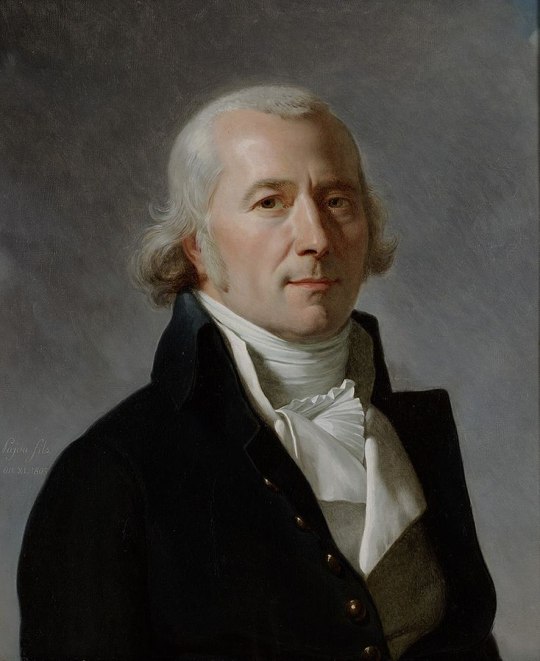
Jacques Augustin Catherine Pajou - Portrait of Frédéric-César de La Harpe - 1803
oil on canvas, height: 60.5 cm (23.8 in); width: 50.3 cm (19.8 in)
Lausanne Museum of History, Lausanne, Switzerland
Frédéric-César de La Harpe (6 April 1754 – 30 March 1838) was a Swiss political leader, writer and journalist, best known for his pivotal role in the independence of the canton of Vaud from Bern and in the formation of the Helvetic Republic, in which he served as a member of its Directory. He was a personal teacher of Alexander I of Russia and educated him in the ideas of the Lumières.
Jacques-Augustin-Catherine Pajou (27 August 1766, Paris - 28 November 1828, Paris) was a French painter in the Classical style.
7 notes
·
View notes
Text
Character Profiles: Antagonists
Index: Dempsey, Flavian, Manon, Maven, Axel, Leon, the "business partner," Yvette, Townsend
(All character ages are as of the latest chapter, or when they died. All information as of the latest chapter too.)
Navigation: Main and extras | Cloudia's grandparents and maternal extended family | Cloudia's paternal extended family (and Florentin) | Other servants and employees | Antagonists | Scotland Yard and misc.
Name: Dempsey Morton
Nickname(s): None
Birthday: November 2, 1803
Age: 43 (at time of death; January 21, 1847)
Physical description: has heterochromia (one eye is brown, the other blue); square head; yellow teeth; very, very ugly
Affiliation: Flavian Hunt
Occupation: 6th Duke of Maverick
Base of Operations: Lone manor in the countryside
Random fact(s): He was not always like this. He used to be a relatively decent person when he was healthy. Back then, he was a very doting uncle to his niece, and she holds him very dear despite everything.
Background info: I liked the sound of “maverick” and forgot to look up its meaning again when I chose it as his title… I’ve been a bit embarrassed about that for years, but I recently found out “Baron of Boringdon” is an actual title (its holders used to live in Boringdon Hall). I guess “Duke of Maverick” isn’t that much of a strange title after all?
First appearance: The Countess, Scary (Chapter 5)
----
Name: Flavian Hunt
Nickname(s): None
Birthday: August 31, 1800
Age: 46 (at time of death; January 21, 1847)
Physical description: black hair; tall and thin; has a tiny moustache
Affiliation: Hunt Trading Company
Occupation: Director of Hunt Trading Company
Base of Operations: London
Random fact(s): He had horrible bouts of jealousy since he was a child (his siblings’ accomplishments were met with disdain and, if possible, swiftly destroyed). Nevertheless, he often wondered why he was never invited to family events, and no one ever answered his letters.
Background info: None.
First appearance: The Countess, Scary (Chapter 5)
----
Name: Manon von Brandt
Nickname(s): None
Birthday: November 17, 1817
Age: 30
Physical description: brown hair (fades to grey at the tips), brown eyes
Affiliation: Von Brandt-Shallow family; the “business partner”
Occupation: Viscountess of Meinkot-Velpke
Base of Operations: Meinkot Manor; “Witch’s Castle”
Random fact(s):
Ever since she was a child, Manon could get away with everything and come out of everything unscathed.
She once persuaded her younger sister to badger a wild dog. It ended up biting her in the hand, and its functionality was never the same again. Manon never took responsibility for her actions.
Her surname is technically “Shallow” too, but she and her husband have been hiding it.
Background info:
Manon is based on Mare Barrow from Red Queen, a book I hate. Her husband and servants are references to characters from that book too, as are the three people whose souls Cedric collects in “The Countess, Restless” (Evangeline May, Lucas Warren, and Shade Haven.) November 17 is Mare’s birthday in that book series.
The surname “von Brandt” (Brand = fire) is a nod to Maven’s magic power in the book.
Meinkot-Velpke is the name of an actual place. “Meinkot” means “my shit,” and Velpke is the name of the municipality the town is located in. I searched for horrible place names to pick Manon and Maven’s title.
First appearance: The Countess, Unamused (Chapter 17)
----
Name: Maven von Brandt (real name: Meradinus Shallow)
Nickname(s): Mavey
Birthday: December 13, 1816
Age: 31 (at time of death: April 4, 1848)
Physical description: dark blond hair, green eyes
Affiliation: Von Brandt-Shallow family; Velpke Industries
Occupation: Viscount of Meinkot-Velpke; Director of Velpke Industries
Base of Operations: Meinkot Manor
Random fact(s): He never liked it that his parents pushed him to marry Manon who was his late older brother’s fiancée. He always thought she was the epitome of insipidness.
Background info:
He is based on and named after Maven Calore from Red Queen. His real name “Meradinus” comes from the surname of Maven Calore’s mother, Merandus. December 13 is his birthday in that book series. I picked “Shallow” as his surname because it is similar to “Barrow.”
The surname “von Brandt” (Brand = fire) is a nod to Maven’s magic power in Red Queen.
He has black hair and blue eyes in my notes, just like his namesake. I cannot remember why I changed it.
First appearance: The Countess, Restless (Chapter 15)
----
Name: Axel Shade
Nickname(s): None
Birthday: 1821
Age: 27 (at time of death: April 10, 1848)
Physical description: brown hair, honey-coloured eyes
Affiliation: Von Brandt-Shallow family
Occupation: Gardener
Base of Operations: Meinkot Manor; “Witch’s Castle”
Random fact(s):
When he was a child, he wanted to be an actor. He was always delegated to silent background roles though.
Cloudia did not kill him, but his corpse was found in the castle’s courtyard. He had vanished from there during the time Cloudia cannot recall and reappeared dead later. (Because he died elsewhere, he was not on Edmund’s list.)
Background info: He’s named after Axel Mortmain from The Infernal Devices. The names of his parents and his middle names come from Mortmain’s adopted parents: John Thadeus Shade and Anne Evelyn Shade.
First appearance: The Countess, Unamused (Chapter 17)
----
Name: Leon Franklin Melville
Nickname(s): Franklin (much to his chagrin)
Birthday: December 21, 1818
Age: 29 (at time of death: April 10, 1848)
Physical description: brown hair, brown eyes
Affiliation: Von Brandt-Shallow family; the “business partner”
Occupation: Footman
Base of Operations: Meinkot Manor; “Witch’s Castle”
Random fact(s):
He always showed some disturbing behaviour in his childhood. His brother being the preferred child did not help at all and only fuelled him.
He has great ideas, but his execution is rarely the best. His bloodthirst makes him impatient and hinders him from thinking everything through. It both intrigued and disappointed his “business partner.”
Background info:
He’s not named after Herman Melville. Instead, I picked his surname because it means “bad town.”
There’s a German song called “Der Mörder ist immer der Gärtner“ (The murderer is always the gardener) which is a parody for crime/mystery stereotypes. The gardener kills several people throughout the song and is murdered himself at the end – by the butler. The chorus then changes to “the murderer is always the butler.” Axel the gardener, Brenton the butler, and Leon the footman were written as a nod to that song, with the footman being the main culprit of everything this time.
First appearance: The Countess, Unamused (Chapter 17)
----
Name: The “business partner”
Nickname(s): ???
Birthday: ???
Age: ???
Physical description: Male
Affiliation: Manon von Brandt; Leon Melville
Occupation: ???
Base of Operations: “Witch’s Castle”
Random fact(s):
He helped Leon carry out his idea because, even though it was half-cooked, it intrigued him greatly. He had a lot of fun executing it though and playing with the participants.
He was rather disappointed that he could not converse with Cloudia in the end.
Background info: ???
First appearance: The Countess, Wrong Way (Chapter 19)
----
Name: Yvette Guilloux
Nickname(s): None
Birthday: January 25, 1830
Age: 18
Physical description: light brown hair (usually kept in a single braid), brown eyes; has a gentle face
Affiliation: Nicodemus Townsend
Occupation: Mayor’s daughter
Base of Operations: Nanteuil-la-Forêt
Favourite Colour: lilac
Favourite Flower: dandelion
Favourite Dessert: lemon tart
What is in her bag? book, notebook, pencil, handkerchief, set of keys, old locket hiding a small key that lost its lock
Random fact(s):
Despite everything, Marie-Claire was indeed her closest friend. The Guilberts essentially raised Yvette after her mother’s early death because her father could not be bothered. Still, she resented them because they paid more attention to Marie-Claire due to her frailness; she was also jealous of Marie-Claire because of that.
When she was a child, Yvette had a secret lair in the attic of an old, abandoned house – the “cursed house,” to be specific. She was eventually found out and her attic room destroyed. The house later became the hideout for Gaspard, Enzo, and Dominique.
Background info: She’s named after an old classmate of mine whose name was Yves. I contemplated naming her after another old classmate (who once tried to throw a chair at me), but I didn’t in the end because I dislike the female version of his name (Étiennette).
First appearance: The Countess, Mystery (Chapter 22)
----
Name: Nicodemus Townsend
Nickname(s): None
Birthday: February 8, 1822
Age: 26
Physical description: brown hair (currently dyed gold-blond), dark grey eyes
Affiliation: Salisbury Trading (in disguise)
Occupation: Teacher; Chartist
Base of Operations: London; Paris
Favourite Colour: green
Favourite Flower: gladiolus
Favourite Dessert: plum pudding
What is in his bag? paper, gun, knife, notebook, pencil, pocket watch
Random fact(s): Though he was never adept with technology unlike his father, he is good at teaching like his mother – or, rather, he is good at talking. His mother had opened a school after she retired as a governess, and Townsend inherited it upon her death. “Higher callings” have been keeping him away from it though.
Background info:
I named him after Nicodemus Flitch from the third Flavia de Luce book. It’s such an odd name that it stuck with me. (Flitch had created a sect at some point in the past.)
I briefly considered making him French (Nicodème Etienne Bellamy would have been his name then), but I decided to keep him as an Englishman.
First appearance: The Countess, Locomotive Run (Chapter 29)
#character sheets#character profiles#after much delay - finally the last batch!#I had to go through the first and third arc again for this and...... orz#I'm so sorry!#going through them gave me some psych damage - hence the late post^^' (i.a.)#(I also considered omitting that guy from here like I omitted X from the misc section - but let's leave it at one omission heh)
3 notes
·
View notes
Text
The Napoleonic Cadaster (land registry)
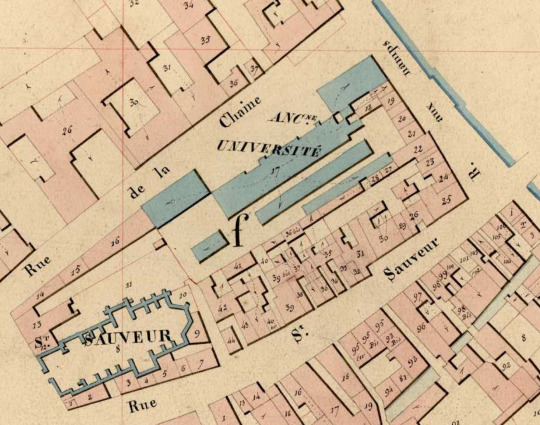
(Cadastre napoléonien – Section I de la commune de Caen)
I’ve compiled a list quotes about the Cadaster in France. According to the exhibition by the European Union’s digital collections, Europeana, the Napoleonic Cadaster was “a tool for equality before the law”.
———
“In an attempt to make sure that these obligations were equitable, Bonaparte in the Year X ordered the formation of a commission to determine how to allocate real-estate taxes with the greatest possible equality. The commission demanded a survey of ownership. Its recommendation was in keeping with the feeling of the Revolutionaries that only a Cadaster, or general survey of the whole nation for appraisal purposes, could make sure everybody paid his fair share; the Convention had ordered a general Cadaster in 1793, but, despite increasing evidence of the need for one, it was begun only under the Consulate.”
— Robert B. Holtman, The Napoleonic Revolution
“Land tenure was better established with the creation of the Cadastre, decided on June 30, 1802, tested from November 2 and extended on October 20, 1803. This Cadastre (the idea of which had been under study since the beginning of the Revolution) was to make it possible to make the land contribution fairer by giving their true value to the plots.”
— Thierry Lentz, Le Grand Consulat
“A law of September 15, 1807, ordered a general survey of each parcel of land, such as the Convention had had in mind. Until the survey was completed in a commune, the value of a parcel of land was to be determined by acts of sale or by the amount charged for leases. The principle of stability of cadastral evaluations laid down by the 1807 law, that an assessment would remain fixed for a long time and would be changeable only with respect to gains or losses of taxable items, has governed French evaluation ever since.”
— Robert B. Holtman, The Napoleonic Revolution
“The cadastre was improved and enhanced under Napoleon with the so-called 'Napoleonian cadastre' (1807). It allowed a fairer taxation, taking into account the rental value of each parcel and the income of each owner. His system was implemented, often complementing existing ones, in several countries such as the Netherlands, Germany and Italy, in which we still find the traces in nowadays cadastre. Far from being only a tax instrument, the cadastre aims to bring equality of all before the law. Therefore property tax can no longer be linked to social conditions: it is now an individual matter, and property is recognised as a sacred and inviolable right.”
— (Europeana exhibition: Napoleon and urbanism in the 19th century / City planning)
“He was inordinately proud of having overseen the introduction of the cadastre, the land registry, which he described as being tantamount to a new constitution in itself, since it fixed everyone's rights to the property they possessed but also because it fixed their taxable status and therefore their position in society. They no longer needed to fear having their property seized, but in return had to submit to the state, in which they thereby gained a stake.”
— Adam Zamoyski, Napoleon: A Life
“The state was there to govern and to lead everyone, without exception. To this end, in 1807, Napoleon himself ordered the most ambitious land survey ever undertaken in France, the Cadastre Parcellaire. This sought to register every piece of property in France, according to ownership and usage. France was divided into twelve districts, each with an inspector-general in charge of the survey, and by 1814 9,000 French communes out of a total of 40,000 had been fully surveyed, and the work continued under the Restoration. The practical aim of the survey was to set taxation on a more accurate footing following complaints from officials and property-owners, alike, over the less detailed cadastre drawn up in 1805. Its significance is much wider, however. Napoleon had both the will and the means to undertake the survey; he had the untrammeled power to make landowners open their properties to government agents, and a civil service ready to carry out the work. He told his Finance Minister, ‘Half measures are always a waste of time and money. The only way forward is to survey all the land in all the communes of the empire.’”
— Michael Broers, Europe Under Napoleon
“The general plot land registry, known as ‘Napoleonic’, was set up by the Finance Act dated 15th September 1807 (decree dated 27th January 1808). Like the land registry by crop mass and nature, it allowed for taxation by distribution, a fairer type of taxation since it took into account the rental value of each plot and the income of each owner.”
“A ‘plot’ was defined as a portion of land with the same type of crop and belonging to the same owner. To establish the land registry, the plots of land in each commune were surveyed, mapped and classified according to soil fertility. Properties, whether they were built (such as houses and buildings) or not (such as meadows, vineyards, fields and so on) were identified, along with each plot owner. The project, which included measuring, estimating and drawing plots of land in about 40,000 communes, i.e. several hundred million plots, would be carried out over several decades.”
“In addition to their fiscal purpose, cadastral documents also had an administrative purpose: proving property ownership. The land registry was made up of two main types of documents: topographical land documentation (plans) and handwritten land documentation (registers). Three documents were produced in the 19th century: the plan, the section status and the matrix. The plot plans showed every plot of land in the commune, with each plot being numbered. In section statuses, the plots of land in a section were listed by number and for each of them, the name of the owner, the nomenclature and the tax data on the date the land registry was drawn up were indicated. Cadastral matrices were registers indicating the list of plots belonging to each owner.”
“For each commune, cadastral plans were drawn up in two copies: the minute plan was kept in the commune and was the one on which the chief surveyor worked, and the ‘department’ or ‘prefecture’ copy was kept at the property tax office to which the commune belonged (there was one office per district). The latter copy was deposited in the Department archives.”
— (Napoléon en Seine-et-Marne)
“A general land register is a monstrous operation which will cost more than thirty million and will take at least twenty years. Measuring and evaluating are not the most difficult operations. It is the knowledge of the relationships between the various departments.”
— Antoine Claire Thibaudeau, Mémoires sur le Consulat
“Speaking of the land register, as he had decided on it, the Emperor said that it could have been considered in itself as the true constitution of the Empire, that is to say the guarantee of properties and the independence of each: because once established and the legislature having fixed the tax, each immediately made his own account, and no longer had to fear the arbitrariness of the authority or that of the assessors; which is an essential point, and the surest means of forcing submission.”
— Las Cases, Le Mémorial de Sainte-Hélène
#Cadastre#cadaster#napoleon#napoleonic era#napoleonic#napoleon bonaparte#first french empire#19th century#land registry#french empire#french revolution#history#frev#la révolution française#france#reforms#napoleonic reforms#Napoleon’s reforms
14 notes
·
View notes
Text
Let us remember Francis Trollope on the anniversary of her birth

Oil on canvas of Frances Trollope by Auguste Hervieu, c. 1832Born
Born Frances Milton on 10 March 1779 in Bristol, England
Died 6 October 1863 (aged 84) in Florence, Italy
Other names: Fanny Trollope
Occupation: Novelist
Notable work: Domestic Manners of the Americans
Spouse: Thomas Anthony Trollope (m. 1809; died 1835)
Children7; including Thomas, Anthony and Cecilia
Parent(s)William Milton Mary Gresley
Frances Milton Trollope, also known as Fanny Trollope (10 March 1779 – 6 October 1863), was an English novelist who wrote as Mrs. Trollope or Mrs. Frances Trollope. Her book, Domestic Manners of the Americans (1832), observations from a trip to the United States, is the best known.
She also wrote social novels: one against slavery is said to have influenced Harriet Beecher Stowe, and she also wrote the first industrial novel, and two anti-Catholic novels, which used a Protestant position to examine self-making.
Some recent scholars note that modernist critics have omitted women writers such as Frances Trollope.i n 1839, The New Monthly Magazine claimed, "No other author of the present day has been at once so read, so much admired, and so much abused".
Two of her sons, Thomas Adolphus and Anthony, became writers, as did her daughter-in-law Frances Eleanor Trollope (née Ternan), second wife of Thomas Adolphus Trollope.
Born at Stapleton, Bristol, Frances was the third daughter and middle child of the Reverend William Milton and Mary Milton (née Gresley). Frances was five years old when her mother died in childbirth.[4][5] Her father was remarried to Sarah Partington of Clifton in 1800.[6] She was baptised at St Michael's, Bristol, on 17 March 1779.[7] As a child, Frances read a great amount of English, French and Italian literature. She and her sister later moved to Bloomsbury, London, in 1803 to live with their brother, Henry Milton, who was employed in the War Office.[6]
Marriage and family
In London, she met Thomas Anthony Trollope, a barrister. At the age of 30, she married him on 23 May 1809 in Heckfield, Hampshire. They had four sons and three daughters:[8] Thomas Adolphus, Henry, Arthur (who died in 1824) Emily (who died in a day), Anthony, Cecilia and Emily. When the Trollopes moved to a leased farm at Harrow-on-the-Hill in 1817, they faced financial struggles for lack of agricultural expertise.[6] This was where Frances gave birth to her last two children.[5] Two of her sons and one daughter also became writers. Her eldest surviving son, Thomas Adolphus Trollope, wrote mostly histories: The Girlhood of Catherine de Medici, History of Florence, What I Remember, Life of Pius IX, and some novels. Her fourth son Anthony Trollope became a well-known and received novelist, establishing a strong reputation, especially for his serial novels, such as those set in the fictional county of Barsetshire, and his political series the Palliser novels. Cecilia Trollope Tilley published a novel in 1846.
Despite producing six living children, the Trollopes' marriage was reputedly unhappy.
Move to America
Soon after the move to the leased farm, her marital and financial strains led Frances to seek companionship and aid from Fanny Wright, ward of the French hero Gilbert du Motier, Marquis de Lafayette. In 1824 she visited La Grange, Lafayette's estate in France.[6] Over the next three years, she made several other visits to France and was inspired to take an American excursion with Wright. Frances thought of America as a simple economic venture and figured that she could save money by sending her children through Wright's communal school, as Wright had planned to reform the education of African American children and the formerly enslaved on their property in Tennessee.[9] In November 1827, Frances Trollope went with some of her family to Fanny Wright's utopian community Nashoba Commune in the United States. She took her son, Henry, and her two daughters, Charlotte and Emily. Her husband, Thomas Anthony, and remaining sons, Tom and Anthony, stayed at home and continued their education. In October 1828, Tom and his father joined Frances in Cincinnati, leaving Anthony at boarding school.[10] They returned to England in January 1829.
Arriving in the United States one year earlier than her husband, she developed an intimate relationship with Auguste Hervieu, a collaborator in her venture. (This is not verified.) After the community failed, Trollope moved to Cincinnati, Ohio with her family.[6] She also encouraged the sculptor Hiram Powers to do Dante Alighieri's Commedia in waxworks.
Nonetheless, all the ways she tried to support herself in America were unsuccessful. She found the cultural climate uninteresting and came to resent democracy. Furthermore, after her venture failed, her family was more in debt than when she had migrated there and they were forced to move back to England in 1831.
Return to Europe
From her return at the age of 50 until her death, Trollope's need of an income for her family and to escape her debts led her to begin writing novels, memoirs of her travels, and other shorter pieces, while travelling around Europe. She became well acquainted with elites and figures of Victorian literature including Elizabeth Barrett, Robert Browning, Charles Dickens, Joseph Henry Green and R. W. Thackeray (a relative of William Makepeace Thackeray).
She wrote more than 41 books: six travelogues, 35 novels, countless controversial articles, and poems. In 1843, Frances visited Italy and eventually moved to Florence permanently.
Trollope already gained notice with her first book Domestic Manners of the Americans (1832). She gave an unfavourable, and in the opinions of America's partisans, an exaggerated account. Her novel, The Refugee in America (1832), expressed similar views, prompting Catharine Sedgwick to respond that "Mrs. Trollope, though she has told some disagreeable truths, has for the most part caricatured till the resemblance is lost." She was thought to reflect the disparaging views of American society that were allegedly commonplace at that time among English people of the higher social classes.
Later Trollope wrote further travel works, such as Belgium and Western Germany in 1833 (1834), Paris and the Parisians in 1835 (1836), and Vienna and the Austrians (1838). Among those with whom she became acquainted in Brussels was the future novelist Anna Harriett Drury.
Novels
Next came The Abbess (1833), an anti-Catholic novel, as was Father Eustace (1847). While both borrowed from Victorian Gothic conventions, the scholar Susan Griffin notes that Trollope wrote a Protestant critique of Catholicism that also expressed "a gendered set of possibilities for self-making", which has been little recognised by scholars. She noted that "Modernism's lingering legacy in criticism meant overlooking a woman's nineteenth century studies of religious controversy."[14]
Trollope received more attention in her lifetime for what are considered several strong novels of social protest: Jonathan Jefferson Whitlaw (1836) was the first anti-slavery novel, influencing the American Harriet Beecher Stowe's Uncle Tom's Cabin (1852). It focuses on two powerful families – one that strongly encourages slavery and another that strongly opposes it and provides sanctuary for slave refugees. It antagonizes pro-slavery characters, making them appear foolish and uncultured. Frances also brings out her idea of a stereotypical American by drawing certain characters as shrewd, convincing, sly and greedy.
Published in 1840, Michael Armstrong, the Factory Boy was the first industrial novel to be published in Britain, inspired by Frances's visit to Manchester in 1832, where she examined the conditions of children employed in the textile mills. The story of a factory boy who is rescued by a wealthy benefactor at first, but later returns to the mills, illustrates the misery of factory life and suggests that private philanthropy alone will not solve the widespread misery of factory employment. Other socially conscious novels of hers include The Vicar of Wrexhill (1837, Richard Bentley, London, 3 volumes), which took on the issue of corruption in the Church of England and evangelical circles. Possibly her greatest work is the Widow Barnaby trilogy (1839–1855), which includes the first ever sequel.[18] In particular, Michael Sadleir considers the skilful set-up of Petticoat Government [1850], with its cathedral city, clerical psychology and domineering female, as something of a formative influence on her son's elaborate and colourful cast of characters in Barchester Towers, notably Mrs. Proudie.[19]
In later years Frances Trollope continued to write novels and books on miscellaneous subjects – in all over 100 volumes. In her own time, she was considered to have acute powers of observation and a sharp and caustic wit, but her prolific production coupled with the rise of modernist criticism caused her works to be overlooked in the 20th century. Few of her books are now read, but her first and two others are available on Project Gutenberg.
After the death of her husband and daughter, in 1835 and 1838 respectively, Trollope moved to Florence, Italy, having lived, briefly, at Carleton, Eden in Cumbria, but finding that (in her son Tom's words) "the sun yoked his horses too far from Penrith town."[21] One year, she invited Theodosia Garrow to be her house guest. Garrow married her son Thomas Adolphus, and the three lived together until Trollope's death in 1863.She was buried near four other members of the Trollope household in the English Cemetery of Florence.
#Frances Trollope#women in literature#Women's history month#March 10#Anti catholic#Cecilia Trollope Tilley#Frances Eleanor Trollope#Books by women#Domestic Manners of the Americans (1832)#The Refugee in America (1832)#novelist Anna Harriett Drury#The Abbess (1833)#Father Eustace (1847).#Jonathan Jefferson Whitlaw (1836) was the first anti-slavery novel#Michael aarmstrong the Factory Boy(1840) was the first industrial novel#The Vicar of Wrexhill (1837) discuss religious corruption#Widow Barnaby trilogy (1839–1855) included the first sequel#Petticoat Government [1850]#project gutenberg
0 notes
Text
since we're sharing vaccine stories. Check this one out about the Balmis expedition
Colombia and Ecuador experienced a smallpox epidemic and called on the king for supplies.[6]On 30 November 1803, the expedition set off from A Coruña in northwest Spain sailing on Maria Pita. It carried 22 orphan boys (aged 3 to 10) to act as carriers of the cowpox virus. The boys were necessary because the vaccine consisted of infecting patients with cowpox, which is a virus closely related to smallpox but produces a much milder disease that confers immunity to both.

37K notes
·
View notes
Text














In New Orleans, Spanish representatives officially transferred the Louisiana Territory to a French representative on November 30, 1803. Just 20 days later, France transferred the same land to the United States as the Louisiana Purchase.
#Palo Duro Canyon State Park#Texas#Gateway Arch#St. Louis#Missouri#New Mexico#Mississippi River#Route 66#cityscape#landscape#USA#original photography#summer 2014#Louisiana Territory#France#US history#30 November 1803#220th anniversary#Santa Fe#De Vargas Street House#Cathedral Basilica of Saint Francis of Assisi#Oklahoma City#Oklahoma#Lake Overholser#Tucumcari#Gallup#tourist attraction#landmark#white colonialism
0 notes
Text
The Annex – French Quarter Apartments in New Orleans, LA
The Annex – French Quarter Apartments has attracted many people nowadays. After all, it is a famous rental apartment at present. It has stylish three bedroom apartments in New Orleans location, too. For young families, it’s perfect since you’ll have a comfortable, spacious, and accessible apartment home. Apart from that, The Annex promises a lifestyle of centrality, comfort, and convenience. Think about this: it may feel like a stay at a world-class boutique hotel but for a fortunate few, it will be home. With that, you’ll fulfill your dream of an almost perfect apartment home. Lastly, you can ask anyone and they will attest, having a private, access-controlled parking space in the French Quarter is nothing short of a modern luxury. What do you think?
New Orleans, LA
Perhaps, you’re curious about any future event in New Orleans, LA area. If that is the case, you can research Eventbrite posts first before checking out social media. After all, they have many interesting events. First, there will be 2024 Essence Music Festival Hotel Packages Available this coming Thursday, July 4, 2024, at around 3:00 PM at 900 Convention Center Blvd. Second, the Black and White Affair | Essence Festival Weekend is scheduled on Friday, July 5, 2024, at around 10:00 PM at Carver Theater. Lastly, you can also opt to attend the It's a Vibe Daisy Dukes & Cowboy Boots Day Party! 30+ on Saturday, July 6, 2024, at around 2:00 PM at Pour House @ District.
Jackson Square in New Orleans, LA
Jackson Square in New Orleans, LA is an exciting tourist attraction. For those who like parks, you’ll be impressed with the features there. Jackson Square, formerly the Place d'Armes (French) or Plaza de Armas (Spanish), is a historic park in the French Quarter of New Orleans, Louisiana. Moreover, it was declared a National Historic Landmark in 1960, for its central role in the city's history, and as the site where in 1803 Louisiana was made United States territory pursuant to the Louisiana Purchase. In 2012, the American Planning Association designated Jackson Square as one of the Great Public Spaces in the United States. Lastly, Jackson Square has been the site of hundreds of live music events.
LSU Women's Gymnastics National Championship Bobblehead unveiled
Interestingly, there are many exciting news reports in New Orleans, LA area. In a recent news article, the topic was about gymnastics. As reported, the National Bobblehead Hall of Fame and Museum has unveiled their limited-edition LSU Tigers 2024 Women's Gymnastics National Champions Bobblehead. Besides, the bobblehead features LSU's mascot, Mike the Tiger wearing an LSU Gymnastics jacket standing on the 2024 Women's Gymnastics National Championship logo. In addition, the LSU gymnastics team won their first national championship in program history becoming the 8th program in NCAA history to win the women's gymnastics crown. Lastly, the bobbleheads are expected to ship in November and are $40 each.
Link to maps
Jackson Square New Orleans, LA 70116, United States Head northeast on Decatur St toward St Ann St. 0.1 mi Turn left onto Dumaine St 0.4 mi Turn left onto N Rampart St 0.5 mi Turn left onto Iberville St Destination will be on the left 0.1 mi The Annex – French Quarter Apartments 939 Iberville St, New Orleans, LA 70112, United States
0 notes
Text
What Is Marbury V. Madison’s Impact Today?
By Maya Mehta, Seattle University Class of 2025
November 30, 2023

A significant Supreme Court decision from 1803, Marbury v. Madison, still has a significant impact on modern American government. The judicial review theory was developed by Chief Justice John Marshall’s ruling, which gave the court the authority to interpret the Constitution and overturn legislation that clash with it. This historic decision strengthened the judiciary's position as a watchdog against any abuses of power by the legislative and executive branches and established the idea of checks and balances. The Court’s continued responsibility for defending individual rights, maintaining the separation of powers, and guaranteeing the legitimacy of governmental activities is clear evidence of the influence of Marbury v. Madison. Its legacy is deeply rooted in the legal notion of stare decisis, which serves to stabilize the legal system by directing the Supreme Court’s decision-making process. Even though the case is well-known, there are many who argue that it gives the court too much authority and creates discussions about how to strike a balance between democratic government and judicial review. Marbury v. Madison, however, continues to be a benchmark in modern debates over the boundaries of governmental power and the judiciary’s indispensable function in upholding the constitutional system.
For full article please visit
Marbury v. Madison: Shaping the Foundations of Judicial Review and its Enduring Impact on American Governance
at
Washington PreLaw Land
0 notes
Photo

9:30 AM EST November 30, 2023:
Ray Manzarek - "Love Flies Everywhere" From the album Carmina Burana (1983)
Last song scrobbled from iTunes at Last.fm
THE COURT OF LOVE Amor volat
In 1803 a scroll of medieval poems was discovered in the German province of Bavaria among the debris of the secularized monastery of Benedikt-Beuren (\'BURANA").
These lyrics, written primarily in Latin, were determined to be the work of renegade monks and wandeing poets of the 13th century. Their words captured the lost world of rebels and dropouts of the medieval clergy, hard lovers, drinkers, on the move, celebrating existence, rather than living the meditative celebate, cloistered life of the monastery.
In 1935 German composer Carl Orff re-discovered the poems. Impressed with their meaning and rhythm he composed a cantata utilizing the centuries-old verses. He transformed the writings into invocations and profane chants accompanied by numnerous instruments and magical representations.
These songs ("CARMINA") were divided into three primary sections. Springtime -- the life force renewed; In the Tavern -- drinking and gambling; The Court of Love -- passion, sensuality. The sections are pervaded and framed by the Wheel of Fortune ("O Fortuna") perpetually turning, perpetually governing the course of man's existence.
In 1983 Ray Manzarek, long attracted to the spiritual power of Carmina Burana, chose to interpret the piece in a contemporary framework. This presentation intends to create enchanted pictures; to conjure up the ecstasy expressed by the lyrics, an enhanced intense feeling for life akin to the passions and revelry of the wandering poets of so long ago.
0 notes
Text
Marx Christian Price
Marx Christian was born in Germany in 1833. 1852 was listed as his year of immigration from Germany. Due to the year of emigration he was most likely between 18 and 23 years old. He first settled in Brooklyn, NY.
His first marriage was on November 27, 1855 to Elizabeth Staats (born in Brooklyn, New York). Their children were: Wilhen Ludwig Price, born October 4, 1856, died November 14, 1880; George Christian Price, born January 2, 1858 in Brooklyn NY, died May 8, 1908, in Reading, Berks , PA, at age 50, buried at Woodlands Cemetery. George's occupation listed him as a "heater setter", Christian Price in entry for George Price, 1908; Heinrich Leopold Price, born March 20, 1860; Philipa Analie Price, born February 5, 1862; Elizabeth Price died on November 30, 1867.
Upon Elizabeth’s death, Marx Christian married Charlotte Catharina Geist in Philadelphia, PA, on May 5, 1868. Charlotte was born in Deutschland (Germany) on Aug. 25, 1843. Based on the year she left Germany for Philadelphia she was probably between 3-4 years old (between 1848 - 1850). Charlotte was around 20 years old when she married Marx Christian who was between 32-34 years old.
Marx Christian and Charlotte lived in Philadelphia PA: (February 13, 1900 census: Charlotte and Christian Price, 2100 Diamond Street, Ward 32, Philadelphia, Pennsylvania). Marx Christian's occupation was a merchant and tavern owner (1900 US Federal Census, Philadelphia, Pennsylvania).
Their children were: Friederich Leonhardt Price May 29, 1869; Sophia Augusta Price, born August 24, 1870 (n the 1900 Census, Sophia Price was age 30); Robert William Price, August 8, 1871; Charles Friederick Price, born March 17, 1873 in Philadelphia, PA, died June 20, 1909, in Philadelphia, Pennsylvania. Charles was 36, single, and occupation was listed as "Adv. Solicitor N.A". Burial date: June 23, 1909. Charles is buried at Woodlands Cemetery. Christian Price in entry for Charles F. Price, 1909.); buried 1908 Woodlands Cemetery, Philadelphia, PA, USA; Walter Scott Price Sr., born September 26, 1876, died March 18, age 68 in 1945; Lillian Estelle Price, born March 21, 1879 (Married name: Howser. In the 1900 Census, Lillian Price was 21); Margarette Louisa Price, born June 18, 1880, died July 1, 1880.
Charlotte died on February 13, 1910, age 66 years old, in Philadelphia, Philadelphia County, Pennsylvania, USA. She is buried in Woodlands Cemetery, I 665, Philadelphia, Philadelphia County, Pennsylvania, USA (findagrave Memorial ID 97310205). Her obituary read as Charlotte C Price (Charlotte Geist), Mother: Charlotte C; Father: Louie Geist (From the Philadelphia, Pennsylvania, Death Certificates Index, 1803-1915). Her obituary from the Philadelphia Inquirer reads: "Charlotte C. Geist Price, 66y 6m 20d, Married, Daughter of Louie and Charlotte C. Geist, 2100 Diamond Street, 32nd Ward". Philadelphia Inquirer, Feb. 15, 1910: "PRICE - On February 13, 1910, CHARLOTTE C., wife of Christian Price, aged 66 years. Relatives and friends invited to attend the funeral services, at her husband's residence, 2100 Diamond street, on Wednesday, at 2 P. M. Interment at Woodlands Cemetery. Burial: Woodlands Cemetery, Philadelphia, Philadelphia County, Pennsylvania, USA."
(Marx) Christian Price was 76 and widowed in 1910 when the 1900 US Federal Census was conducted.
Sources:
-ancestry.com: a 1900 US Federal Census in Philadelphia, Pennsylvania
-familysearch.org: United States Census, 1900, Household of Christian Price, Philadelphia city Ward 32, Philadelphia, Pennsylvania, United States.
-familysearch.org: Philadelphia City Death Certificates, 1803-1915
-The Marx Christian - Charlotte Geist Price Family Plot in Philadelphia, PA. Marx Christian's burial site was listed in the census records. The plot map and internment records were provided by Woodlands Cemetery, Philadelphia, Philadelphia County, Pennsylvania, USA.
#Marx Christian Price#Walter Scott Price#Walter Scott Price Family History#Price Mansion#Price Mansion Philippines#Charlotte Geist
0 notes
Text
Who is the worst? Round 1: Henry Clay vs Gouverneur Morris

Henry Clay Sr. (April 12, 1777 – June 29, 1852) was an American attorney and statesman who represented Kentucky in both the U.S. Senate and House of Representatives. He was the seventh House speaker as well as the ninth secretary of state. He unsuccessfully ran for president in the 1824, 1832, and 1844 elections. He helped found both the National Republican Party and the Whig Party. For his role in defusing sectional crises, he earned the appellation of the "Great Compromiser" and was part of the "Great Triumvirate" of Congressmen, alongside fellow Whig Daniel Webster and John C. Calhoun.
[Clay and his family] initially lived in Lexington, but in 1804 they began building a plantation outside of Lexington known as Ashland. The Ashland estate eventually encompassed over 500 acres (200 ha), with numerous outbuildings such as a smokehouse, a greenhouse, and several barns. Enslaved there were 122 during Clay’s lifetime with about 50 needed for farming and the household.
In early 1819, a dispute erupted over the proposed statehood of Missouri after New York Congressman James Tallmadge introduced a legislative amendment that would provide for the gradual emancipation of Missouri's slaves. Though Clay had previously called for gradual emancipation in Kentucky, he sided with the Southerners in voting down Tallmadge's amendment. Clay instead supported Senator Jesse B. Thomas's compromise proposal in which Missouri would be admitted as a slave state, Maine would be admitted as a free state, and slavery would be forbidden in the territories north of 36° 30' parallel. Clay helped assemble a coalition that passed the Missouri Compromise, as Thomas's proposal became known. Further controversy ensued when Missouri's constitution banned free blacks from entering the state, but Clay was able to engineer another compromise that allowed Missouri to join as a state in August 1821.
Gouverneur Morris (January 31, 1752 – November 6, 1816) was an American statesman, a Founding Father of the United States, and a signatory to the Articles of Confederation and the United States Constitution. He wrote the Preamble to the United States Constitution and has been called the "Penman of the Constitution". While most Americans still thought of themselves as citizens of their respective states, Morris advanced the idea of being a citizen of a single union of states. He was also one of the most outspoken opponents of slavery among those who were present at the Constitutional Convention. He represented New York in the United States Senate from 1800 to 1803.
After the ratification of the Constitution, Morris served as Minister Plenipotentiary to France. He criticized the French Revolution and the execution of Marie Antoinette.
It is said by some that Morris was "an aristocrat to the core," who believed that "there never was, nor ever will be a civilized Society without an Aristocracy." It is also alleged that he thought that common people were incapable of self-government because he feared that the poor would sell their votes to the rich and that voting should be restricted to property owners. Duff Cooper wrote of Morris that although he "had warmly espoused the cause of the colonists in the American War of Independence, he retained a cynically aristocratic view of life and a profound contempt for democratic theories."
#worst founding father#founding fathers bracket#founding fathers#amrev#brackets#henry clay#gouverneur morris
12 notes
·
View notes